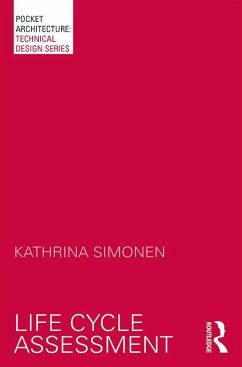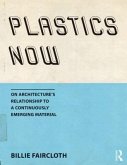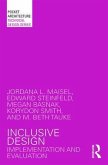Kathrina Simonen
Life Cycle Assessment
Kathrina Simonen
Life Cycle Assessment
- Broschiertes Buch
- Merkliste
- Auf die Merkliste
- Bewerten Bewerten
- Teilen
- Produkt teilen
- Produkterinnerung
- Produkterinnerung
Life Cycle Assessment addresses the dynamic and dialectic of building and ecology, presenting the key theories and techniques surrounding life cycle analysis for holistic ecological building.
Andere Kunden interessierten sich auch für
![Climate and Architecture Climate and Architecture]() Climate and Architecture59,99 €
Climate and Architecture59,99 €![Plastics Now Plastics Now]() Billie FairclothPlastics Now84,99 €
Billie FairclothPlastics Now84,99 €![Earthbag Building Earthbag Building]() Kaki HunterEarthbag Building29,99 €
Kaki HunterEarthbag Building29,99 €![Ecohouse Ecohouse]() Sue RoafEcohouse71,99 €
Sue RoafEcohouse71,99 €![Inclusive Design Inclusive Design]() Jordana L MaiselInclusive Design42,99 €
Jordana L MaiselInclusive Design42,99 €![Architecture in a Climate of Change Architecture in a Climate of Change]() Peter F SmithArchitecture in a Climate of Change58,99 €
Peter F SmithArchitecture in a Climate of Change58,99 €![Aquatecture Aquatecture]() Robert BarkerAquatecture49,99 €
Robert BarkerAquatecture49,99 €-
-
-
Life Cycle Assessment addresses the dynamic and dialectic of building and ecology, presenting the key theories and techniques surrounding life cycle analysis for holistic ecological building.
Produktdetails
- Produktdetails
- Verlag: Taylor & Francis
- Seitenzahl: 182
- Erscheinungstermin: 9. April 2014
- Englisch
- Abmessung: 184mm x 120mm x 10mm
- Gewicht: 236g
- ISBN-13: 9780415702423
- ISBN-10: 0415702429
- Artikelnr.: 41360983
- Herstellerkennzeichnung
- Libri GmbH
- Europaallee 1
- 36244 Bad Hersfeld
- gpsr@libri.de
- Verlag: Taylor & Francis
- Seitenzahl: 182
- Erscheinungstermin: 9. April 2014
- Englisch
- Abmessung: 184mm x 120mm x 10mm
- Gewicht: 236g
- ISBN-13: 9780415702423
- ISBN-10: 0415702429
- Artikelnr.: 41360983
- Herstellerkennzeichnung
- Libri GmbH
- Europaallee 1
- 36244 Bad Hersfeld
- gpsr@libri.de
Kathrina Simonen is an Assistant Professor in the Department of Architecture at the University of Washington. Licensed as both an Architect and Structural Engineer, her research agenda stems from unresolved questions originated during over 15 years of professional practice. Her research topics include life cycle assessment (LCA) and practice innovations such as prefabrication, digital manufacturing, and alternative project delivery models. She is founding director of the Carbon Leadership Forum, an industry/academic research collaborative focused on linking the science of life cycle assessment to industry best practices in order to help enable quantifiable reduction of the environmental impact of the built environment.
1. Life Cycle Assessment Introduction 1. LCA: Environmental Accounting 2.
LCA: Strengths and Weaknesses 3. LCA in the Building Industry 2. Life Cycle
Assessment Fundamentals 1. LCA Goal 2. LCA Scope 3.Inventory Analysis 4.
Impact Assessment 5.Interpretation 3. Environmental Impacts 1.
Acidification 2. Climate Change 3. Eutrophication 4. Ozone Depletion 5.
Smog Formation 6. Human Health and Eco-toxicity 7. Resource Use and
Depletion 8. Consumption of Fresh Water 9. Waste Generation 10. Material
Re-use and Recycling 4. LCA Data 1. Inventory Input: Material & Energy 2.
Inventory Emissions: Unit Process Data 3. Inventory Emissions: Economic
Input Output Data 4. Analysis: Attributional vs. Consequential 5. Analysis:
Data Quality 6. Analysis: Allocation 7. Analysis: Calculation Methods 5.
Life Cycle Assessment Standards 1. Critical Review 2. Comparative
Assertions 3. Environmental Labels: EPDs and More 4. Building Industry
Specific Standards 6. Methodological Challenges 1. Allocation: By-product,
Co-product or Waste? 2. Allocation: Recycling Methodology 3. Allocation:
Biologically Based Carbon 4. Uncertainty: Data Variability in Product LCA
5. Uncertainty: Variability in Whole Building LCA 6. Uncertainty: End of
Life Assumptions 7. Implementing Life Cycle Assessment 1. LCA: Optimism,
Pessimism & Perspective 2. LCA Resources Abbreviations Index (and reference
to standard definitions) Bibliography
LCA: Strengths and Weaknesses 3. LCA in the Building Industry 2. Life Cycle
Assessment Fundamentals 1. LCA Goal 2. LCA Scope 3.Inventory Analysis 4.
Impact Assessment 5.Interpretation 3. Environmental Impacts 1.
Acidification 2. Climate Change 3. Eutrophication 4. Ozone Depletion 5.
Smog Formation 6. Human Health and Eco-toxicity 7. Resource Use and
Depletion 8. Consumption of Fresh Water 9. Waste Generation 10. Material
Re-use and Recycling 4. LCA Data 1. Inventory Input: Material & Energy 2.
Inventory Emissions: Unit Process Data 3. Inventory Emissions: Economic
Input Output Data 4. Analysis: Attributional vs. Consequential 5. Analysis:
Data Quality 6. Analysis: Allocation 7. Analysis: Calculation Methods 5.
Life Cycle Assessment Standards 1. Critical Review 2. Comparative
Assertions 3. Environmental Labels: EPDs and More 4. Building Industry
Specific Standards 6. Methodological Challenges 1. Allocation: By-product,
Co-product or Waste? 2. Allocation: Recycling Methodology 3. Allocation:
Biologically Based Carbon 4. Uncertainty: Data Variability in Product LCA
5. Uncertainty: Variability in Whole Building LCA 6. Uncertainty: End of
Life Assumptions 7. Implementing Life Cycle Assessment 1. LCA: Optimism,
Pessimism & Perspective 2. LCA Resources Abbreviations Index (and reference
to standard definitions) Bibliography
1. Life Cycle Assessment Introduction 1. LCA: Environmental Accounting 2.
LCA: Strengths and Weaknesses 3. LCA in the Building Industry 2. Life Cycle
Assessment Fundamentals 1. LCA Goal 2. LCA Scope 3.Inventory Analysis 4.
Impact Assessment 5.Interpretation 3. Environmental Impacts 1.
Acidification 2. Climate Change 3. Eutrophication 4. Ozone Depletion 5.
Smog Formation 6. Human Health and Eco-toxicity 7. Resource Use and
Depletion 8. Consumption of Fresh Water 9. Waste Generation 10. Material
Re-use and Recycling 4. LCA Data 1. Inventory Input: Material & Energy 2.
Inventory Emissions: Unit Process Data 3. Inventory Emissions: Economic
Input Output Data 4. Analysis: Attributional vs. Consequential 5. Analysis:
Data Quality 6. Analysis: Allocation 7. Analysis: Calculation Methods 5.
Life Cycle Assessment Standards 1. Critical Review 2. Comparative
Assertions 3. Environmental Labels: EPDs and More 4. Building Industry
Specific Standards 6. Methodological Challenges 1. Allocation: By-product,
Co-product or Waste? 2. Allocation: Recycling Methodology 3. Allocation:
Biologically Based Carbon 4. Uncertainty: Data Variability in Product LCA
5. Uncertainty: Variability in Whole Building LCA 6. Uncertainty: End of
Life Assumptions 7. Implementing Life Cycle Assessment 1. LCA: Optimism,
Pessimism & Perspective 2. LCA Resources Abbreviations Index (and reference
to standard definitions) Bibliography
LCA: Strengths and Weaknesses 3. LCA in the Building Industry 2. Life Cycle
Assessment Fundamentals 1. LCA Goal 2. LCA Scope 3.Inventory Analysis 4.
Impact Assessment 5.Interpretation 3. Environmental Impacts 1.
Acidification 2. Climate Change 3. Eutrophication 4. Ozone Depletion 5.
Smog Formation 6. Human Health and Eco-toxicity 7. Resource Use and
Depletion 8. Consumption of Fresh Water 9. Waste Generation 10. Material
Re-use and Recycling 4. LCA Data 1. Inventory Input: Material & Energy 2.
Inventory Emissions: Unit Process Data 3. Inventory Emissions: Economic
Input Output Data 4. Analysis: Attributional vs. Consequential 5. Analysis:
Data Quality 6. Analysis: Allocation 7. Analysis: Calculation Methods 5.
Life Cycle Assessment Standards 1. Critical Review 2. Comparative
Assertions 3. Environmental Labels: EPDs and More 4. Building Industry
Specific Standards 6. Methodological Challenges 1. Allocation: By-product,
Co-product or Waste? 2. Allocation: Recycling Methodology 3. Allocation:
Biologically Based Carbon 4. Uncertainty: Data Variability in Product LCA
5. Uncertainty: Variability in Whole Building LCA 6. Uncertainty: End of
Life Assumptions 7. Implementing Life Cycle Assessment 1. LCA: Optimism,
Pessimism & Perspective 2. LCA Resources Abbreviations Index (and reference
to standard definitions) Bibliography








